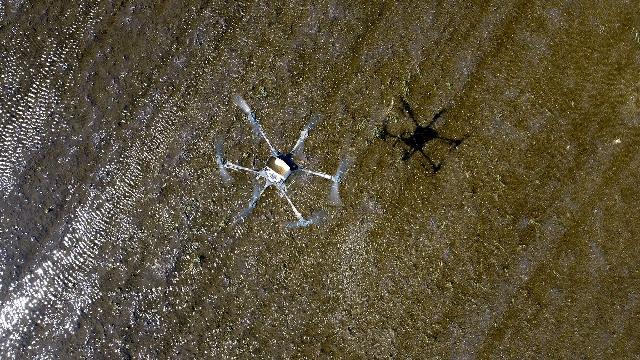Heavy drones will be used in the dark.
The troops began to create branches of agricultural drones. They are equipped with agricultural copters and their analogues. Such vehicles can carry tens of kilograms of combat load and destroy fortifications and equipment, or carry other drones on board. Separating them into separate units is an effective solution, experts say.
Advantages and disadvantages of agricultural drones
Departments of agricultural drones have begun to form in the UAV services of the battalions, sources in the military department told Izvestia. They include multi-purpose copters, originally created for agricultural work, analogues of the famous Ukrainian "Baba Yaga". They are used to ensure assault operations. They destroy fortifications of strongholds by dropping ammunition, as well as hitting vehicles. In addition, they can conduct remote mining, blocking the enemy's escape routes.
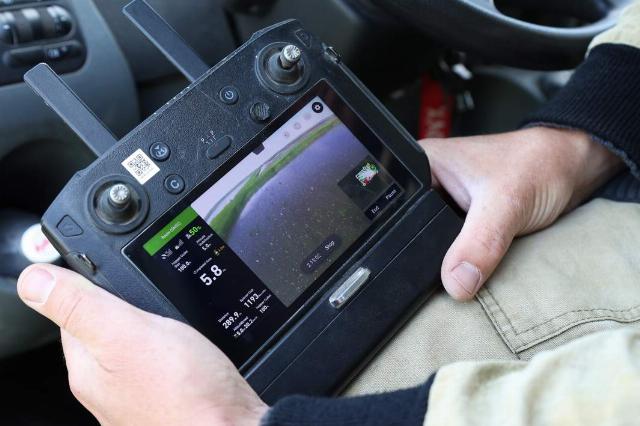
Photo: RIA Novosti/Vitaly Timkiv
Image source: iz.ru
"Baba Yaga" is a common nickname for agricultural copters, which the Ukrainian Armed Forces actively use as bombers. Initially, these devices were designed to spray chemicals over crops. However, during the fighting, they revealed a number of advantages suitable for military use. In particular, they can carry a much greater load than drones designed for video filming. The weight of the ammunition can reach several tens of kilograms.
Agricultural drones can use a wide variety of ammunition: mortar shells, grenade launchers, shaped-action grenades, anti-tank mines, and others.
Agrodrones also have disadvantages. Due to their large size, they are not fast or maneuverable, meaning they can become an easy target, and therefore are usually used at night. For example, the Baba Yaga, when fully loaded, flies no higher than 30 meters above the ground and at a speed of about 40 km/h. Therefore, the APU equips them with thermal imagers and is used mainly at night.
— This is an effective solution. Conventionally, such drones are called agricultural, but in fact, drones with a certain payload capacity fall under this classification," Roman Shkurlatov, chairman of the Officers of Russia public organization, told Izvestia. — As a rule, these are eight—rotor octocopter machines. They can carry up to several anti-tank mines or comparable ammunition. When used by our side and the enemy, such devices have proven themselves well.
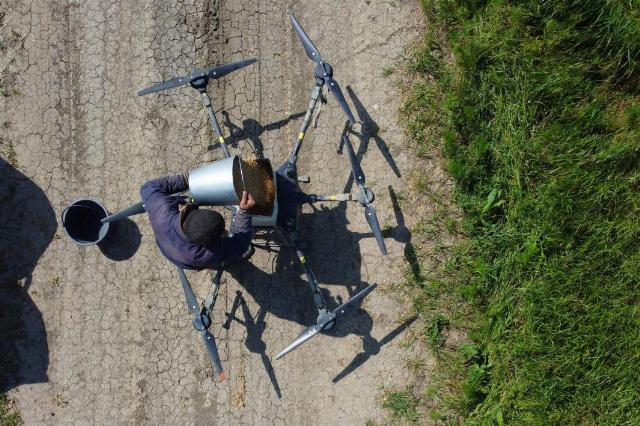
Photo: RIA Novosti/Vitaly Timkiv
Image Source: iz.ru
According to the expert, such drones can perform a wide range of tasks.
— They can act as repeaters. They are equipped with equipment that amplifies the signal, which can increase the range of FPV drones by several tens of kilometers. It can also serve as a carrier for FPV drones. It is hanging, several devices are fixed on it, if necessary, they start and go to the target. The use of such devices is very wide. Therefore, it is absolutely true that specialized formations have begun to appear. They have their own specifics, and we need people who have special skills. And they need to be separated into separate units," Roman Shkurlatov concluded.
Large drones that can carry many striking elements or small UAVs are a promising area, military expert Alexei Leonkov told Izvestia.
"The advantage of such a drone is that it can carry a large amount of payload, be it ammunition or additional drones, for which it will act as a repeater," he told Izvestia. — Without entering the air defense zone, he can send drones to perform combat missions. Now this area of UAVS in the military is being improved, a list of devices is being sought that will be mass-produced and will become part of a new type of armed forces.
—The specifics of using such drones are such that it requires a well—coordinated team," Sergei Kurapov, a researcher at the Razumovsky Moscow State Technical University, told Izvestia. — That is, these units must be worked out — complex equipment requires an appropriate approach. But we have no problems with this: we have very well-managed Lancet operators, which are even more complex. Therefore, working with such devices does not pose any problem for our fighters, the operators adapt quickly enough. If these drones start to be supplied everywhere, then, accordingly, the tactics of their use will spread.
Photo: RIA Novosti/Vitaly Timkiv
Image source: iz.ru
Soldiers of the commander's reconnaissance unit with the call sign Aid of the Akhmat special forces, who fought in the Kursk region, told Izvestia that Baba Yaga was actively spreading mines on the roads, which complicated the movement and supply of troops.
"They're constantly refining Baba Yaga," said a soldier with the call sign Pirate. — The gasoline engine was changed to an electric one to make it quieter. They began to attach an armored plate from below to make it more difficult to knock it down. But nothing helps them, we are coping.
What are the analogues of Baba Yaga in Russia?
There are developments in Russia that are comparable in characteristics to Baba Yaga. In particular, Izvestia reported on the Buran hexacopter UAV . It is capable of carrying loads weighing up to 80 kg at a speed of 70 km/h. It can be used to deliver supplies directly to the front line and even to evacuate the wounded. If necessary, it can be adapted for dropping ammunition, as well as for conducting reconnaissance, including at night, using thermal imagers. The drone has already been nicknamed the Russian "Baba Yaga", but our machine surpasses its opponent in many characteristics. Most importantly, it is about twice as long as the flight range.
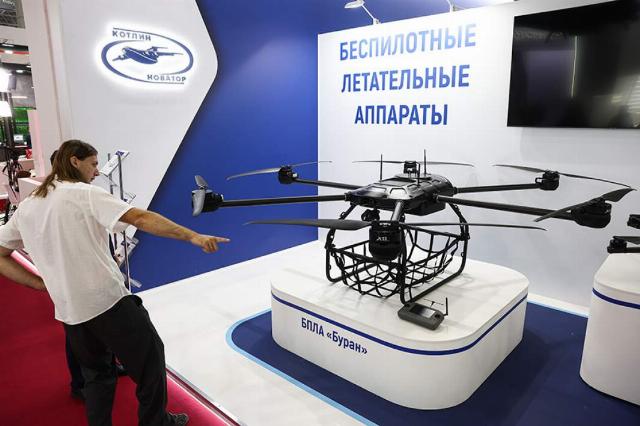
Photo: TASS/Sergey Bulkin
Image source: iz.ru
Izvestia also wrote about the start of mass production of the MiS-35 attack and reconnaissance hexacopter. It is a tactical drone that can drop ammunition and conduct reconnaissance. At the front line, where the device was tested, it has already been nicknamed the "mini Baba Yaga" for its resemblance to drones used by the Armed Forces of Ukraine.
The MiS-35 is somewhere between Mavik and Baba Yaga in size. Compared to the latter, it has less visibility — visual, thermal, and noise. On the front line, the MiS-35 is used to drop 82mm mortar shells and PG-7 ammunition, which is a shaped charge from an RPG-7 hand grenade launcher.
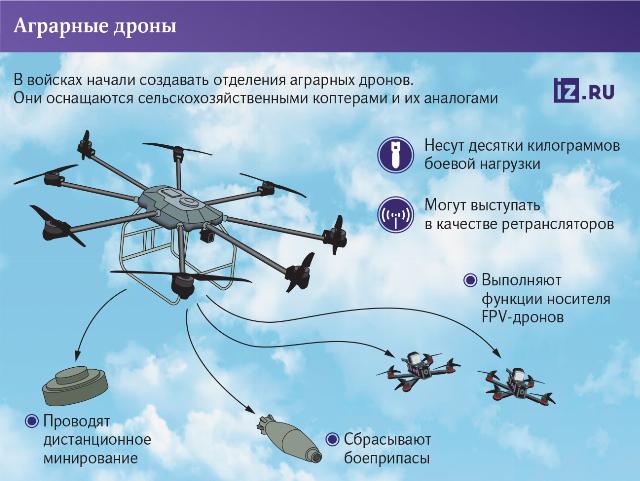
The combat radius of the hexacopter during departure with a load of 3.5 kg is nine kilometers, with a maximum payload of 4.5 kg. In the reconnaissance mission mode, he can stay in the air for up to 45 minutes. The drone accelerates to 63 km/h. With full load, the flight time of the drone is reduced to 30-32 minutes. The device has proven itself well on the line of combat contact.
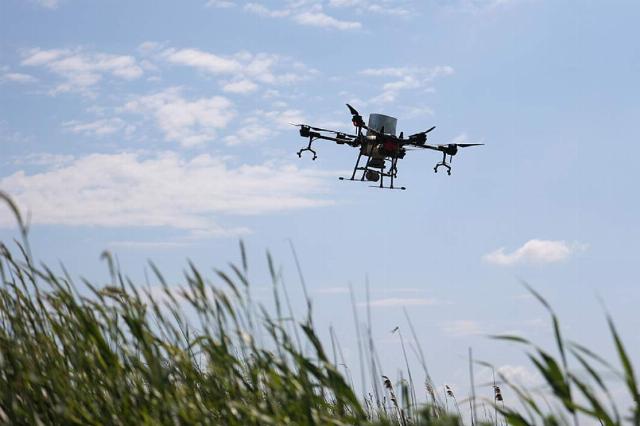
Photo: RIA Novosti/Vitaly Timkiv
Image source: iz.ru
Earlier, Izvestia reported that reconnaissance and strike divisions of unmanned aerial vehicles had been formed in the artillery brigades. They are armed with a whole range of drones and barrage ammunition. With the help of these systems, gunners find and destroy enemy guns, self-propelled guns and MLRS, air defense systems and personnel both on the line of contact and behind enemy lines. Drones are also hunting for enemy UAV calculations, and they are successfully working on targets covered by electronic warfare.
Roman Kretsul
